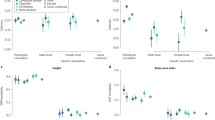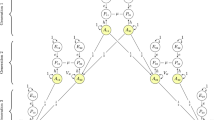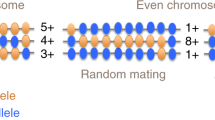Abstract
Most work on the genetics of relative weight has not considered the role of assortative mating, i.e., mate selection based on similarity between mates. We investigated the extent to which engaged men and women in an archival longitudinal database were similar to each other in relative body weightprior to marriage and cohabitation. After controlling for age, a small but statistically significant mate correlation was found for relative weight (r=.13,p=.023), indicating some assortative mating. Furthermore, we examined whether mate similarity in relative weight prior to marriage predicts survival of the marriage. No significant effects were found. In sum, these results are consistent with those of other studies in suggesting that there is a small but significant intermate correlation for relative weight. However, they are unique in showing that these results cannot be explained on the basis of (a) cohabitation, (b) age similarity, or (c) selective survival of marriages between couples more similar in relative weight. The implications of these findings for heritability studies, linkage studies, and the estimation of shared environmental effects are discussed.
Similar content being viewed by others
References
Allison, D. B., Heshka, S., Neale, M. C., Lykken, D. T., and Heymsfield, S. B. (1994a). A genetic analysis of relative weight among 4,020 twin pairs, with an emphasis on sex effects.Health Psychol.13(4):362–365.
Allison, D. B., Heshka, S., Neale, M. C., and Heymsfield, S. B. (1994b). Race effects in the genetics of adolescent's Body Mass Index.Int. J. Obesity 18:363–368.
Andres, R. (1985). Mortality and obesity: The rationale for age-specific height-weight tables. In Andres, R., Bierman, E. L., and Hazzard, W. R. (eds.),Principles of Geriatric Medicine, McGraw-Hill, New York, pp. 311–318.
Annest, J. L., Sing, C. F., Biron, P., and Mongeau, J. G. (1983). Familial aggregation of blood pressure and weight in adoptive families. III. Analysis of the role of shared genes and shared household environment in explaining family resemblance for height, weight and selected weight/height indices.Am. J. Epidemiol. 117:492–506.
Becher, H. (1992). The concept of residual confounding in regression models and some applications.Stat. Med. 2: 1747–1758.
Bollen, K. A., and Barb, K. H. (1981). Pearson's R and coarsely categorized measures.Am. Psychol. Rev. 46:232–239.
Bouchard, C. (1989). Genetic factors in obesity.Med. Clin. North Am. 73:67–81.
Bouchard, C. (1991). Current understanding of the etiology of obesity: Genetic and nongenetic factors.Am. J. Clin. Nutr. 53:1561S-1565S.
Bouchard, C., Perusse, L., Leblanc, C., Tremblay, A., and Theriault, G. (1988). Inheritance of the amount and distribution of human body fat.Int. J. Obesity 12:205–215.
Brook, C. G. D., Huntley, R. M. C., and Slack, J. (1975). Influence of heredity and environment in determination of skinfold thickness in children.Br. Med. J. 2:719–721.
Buss, D. M. (1984). Marital assortment for personality dispositions: Assessment with three different data sources.Behav. Genet. 14:111–123.
Cochran, W. G. (1968). The effectiveness of adjustment by subclassification in removing bias in observational studies:Biometrics 24:295–313.
Cohen, J. (1983). The cost of dichotomization.Appl. Psychol. Measure. 7:249–253.
Eaves, L. J., Eysenck, H. J., and Martin, N. G. (1989).Genes, Culture and Personality: An Empirical Approach, Academic Press, New York.
Friedlander, Y., Kasrk, J. D., Kaufman, N. A., Berry, E. M., and Stein, Y. (1988). Familial aggregation of body mass index in ethnically diverse families in Jerusalem. The Jerusalem lipid research clinic.Int. J. Obesity 12:237–247.
Garn, S. M., Cole, P. E., and Bailey, S. M. (1979). Living together as a factor in familyline resemblances.Hum. Biol. 51:565–587.
Gimelfarb, A. (1988). Processes of pair formation leading to assortative mating in biological populations: Dynamic interaction modelTheoret. Popul. Biol. 34:1–23.
Grilo, C. M., and Pogue-Geile, M. F. (1991). The nature of environmental influences on weight and obesity: A behavior genetic analysis.Psychol. Bull. 110:520–537.
Harrison, G. A., Gibson, J. B., and Hiorns, R. W. (1976). Assortative marriage for psychometric, personality, and anthropometric variation in a group of Oxfordshire villages.J. Biosoc. Sci. 8:145–153.
Hartz, A., Giefer, E., and Rimm, A. A. (1977). Relative importance of the effect of family environment and heredity on obesity.Ann. Hum. Genet. 41:185–193.
Haseman, J. K., and Elston, R. C. (1972). The investigation of linkage between a quantitative trait and marker locus.Behav. Genet. 2(1):3–19.
Hedrick, P. W. (1985).Genetics of Populations, Jones and Bartlett, Boston.
Heymsfield, S. B., Lichtman, S., Baumgartner, R. N., Dilmanian, A., and Kamen, Y. (1992). Assessment of body composition: An overview. In Bjomttorp, P., and Brodoff, B. N. (eds.),Obesity, J. P. Lippincott, Philadelphia, pp. 37–54.
Heymsfield, S. B., Allison, D. B., Heshka, S., and Pierson, R. N. (1995). Assessment of human body composition. InHandbook of Assessment Methods for Eating Behaviors and Weight Related Problems, Sage, Beverly Hills, CA.
Hodge, S. E. (1992). So bilineal pedigrees represent a problem for linkage analysis? Basic principles and simulation results for single-gene diseases with no heterogeneity.Genet. Epidemiol. 9:191–206.
Hutchinson, J., and Byard, P. J. (1987). Family resemblance for anthropometric and blood pressure measurements in Black Caribs and Creoles from St. Vincent Island.Am. J. Phys. Anthropol. 73:33–39.
Johnston, R. E. (1970). Phenotypic assortative mating among the Peruvian Cashinahua.Soc. Biol. 17:37–42.
Kelly, E. L. (1935).The Kelly Longitudinal Study, Henry A. Murray Research Center, Radcliffe College, Cambridge, MA.
Korkeila, M., Kaprio, J., Rissanen, A., and Koskenvuo, M. (1991). Effects of gender and age on the heritability of body mass index.Int. J. Obesity 15:647–654.
Kuczmarski, R. J., Flegal, K. M., Campbell, S. M., and Johnson, C. L. (1994). Increasing prevalence of overweight among US adults. The National Health and Nutrition Examination Surveys, 1960 to 1991.JAMA 272: 205–211.
Malina, R. M., Selby, H. A., Buscang, P. H., Aronson, W. L., and Little, B. B. (1983). Assortative mating for phenotypic characteristics in a Zapotec community in Oaxaca, Mexico.J. Biosoc. Sci. 15:273–280.
Mason, E. (1970). Obesity in pet dogs.Vet. Rec. 86:612–616.
Mascie-Taylor, C. G. N. (1988). Assortative mating for psychometric characters. In Mascie-Taylor, G. C. N., and Boyce, A. J. (eds.),Human Mating Patterns. Society for the Study of Human Biology Symposium Series 28, Cambridge University Press, New York, pp. 61–82.
Meier, R. J. (1990). Assortative mating in monozygotic twins.Soc. Biol. 37:128–136.
Neale, M. C., and Cardon, L. R. (1992).Methodology for Genetic Studies of Twins and Families, Kluwer Academic, Dorchrect, The Netherlands.
Ott, J. (1991).Analysis of Human Genetic Linkage, Johns Hopkins University Press, London, pp. 25, 218–219.
Peters, C. C., and Van Voorhis, W. R. (1940).Statistical Procedures and Their Mathematical Bases, McGraw-Hill, New York.
Plomin, R., DeFries, J. C., and Roberts, M. K. (1977). Assortative mating by unwed biological parents of adopted children.Science 196:449–450.
Plomin, R., DeFries, J. K., and McClearn, G. (1990).Behavioral Genetics, 2nd ed., W. H. Freeman, New York.
Price, R. A., and Vandenberg, S. G. (1980). Spouse similarity in American and Swedish couples.Behav. Genet. 10:59–71.
Price, R. A., Cadoret, R. J., Stunkard, A. J., and Troughton, E. (1987). Genetic contributions to human fatness: An adoption study.Am. J. Psychiat. 144:1003–1008.
Shapiro, J., Gilborn, N., and Groture, J. (1991).A Guide to Data Resources, Henry A. Murray Research Center, Radcliffe College, Cambridge, MA.
Sorenson, T. I., Holst, C., Stunkard, A. J., and Skovgaard, L. T. (1992). Correlations of body mass index of adult adoptees and their biologic and adoptive relatives.Int. J. Obesity 16:227–236.
Spuhler, J. N. (1968). Assortative mating with respect to physical characteristics.Eugen. Q. 15:128–140.
Sribney, W. M., and Swift, M. (1992). Power of sib-pair and sib-trio linkage analysis with assortative mating and multiple disease loci.Am. J. Hum. Genet. 51:773–784.
Stark, A. E., Salzano, F. M., and Da Rocha, F. J. (1990). Marital correlation for anthropometric characteristics in Brzzilian Indians.Ann. Hum. Biol. 47:417–422.
Stunkard, A. J., Foch, T. T., and Hrubec, Z. (1986). A twin study of human obesity.JAMA 256:51–54.
Stunkard, A. J., Harris, J. R., Pederson, N. L., and McClearm, G. E. (1990). The body-mass index of twins who have been reared apart.N. Engl. J. Med. 322:1438–1437.
Susanne, C. (1979). Assortative mating: Biodemographical structure of human populations.J. Hum. Evol. 8:799–804.
Sutton, G. C. (1993). Do men grow to resemble their wives, or vice versa?.J. Biosoc. Sci. 25:25–29.
Tambs, K., Moum, T., Eaves, L. J., Neale, M. C., Mikthjell, K., Naess, S., and Holmen, J. (1991). Genetic and environmental contributions to the variance of body mass index in a large sample of first and second degree relatives.Am. J. Hum. Biol. 3:257–267.
Zhang, Y., Proenca, R., Maffei, M., Barone, M., Leopold, L., and Friedman, J. M. (1994). Positional cloning of the mouseobese gene and its human homologue.Nature 372: 425–432.
Zonata, C. A., Jayakar, S. D., Bossio, M., Galante, A., and Pennetti, V. (1987). Genetic analysis of obesity in an Italian sample.Hum. Hered. 37:129–139.
Author information
Authors and Affiliations
Corresponding author
Rights and permissions
About this article
Cite this article
Allison, D.B., Neale, M.C., Kezis, M.I. et al. Assortative mating for relative weight: Genetic implications. Behav Genet 26, 103–111 (1996). https://doi.org/10.1007/BF02359888
Received:
Accepted:
Issue Date:
DOI: https://doi.org/10.1007/BF02359888




